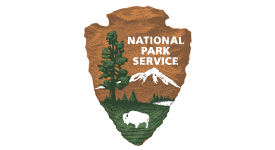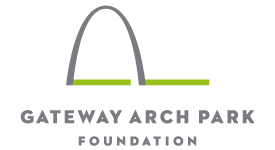Our visitors have been seeing differently from the very beginning.
Founded by the National Park Service in 1935 to commemorate Thomas Jefferson’s vision of a transcontinental United States, the Gateway Arch National Park (formerly known as the “Jefferson National Expansion Memorial”) stretches from the Old Courthouse to the steps overlooking the Mississippi River. In between, the Gateway Arch rises high, a bold monument to the pioneering spirit.
Today, the Gateway Arch celebrates the diverse people who shaped the region and the country. The dreamer, Thomas Jefferson, negotiated the Louisiana Purchase in 1803, doubling the size of the United States. The explorers, Lewis & Clark and their Shoshone guide Sacagawea, scouted the new territory and mapped a route to the Pacific Ocean. The challengers, Dred and Harriet Scott, filed suit at the Old Courthouse for their freedom from slavery, and St. Louis suffragette Virginia Minor sued for women’s right to vote. The artist, architect Eero Saarinen, designed the monument that honors them all.
The monument we know today began in 1935, when President Franklin D. Roosevelt designated property along the St. Louis riverfront to be developed as the Jefferson National Expansion Memorial (now known as Gateway Arch National Park). While the land was cleared for construction, the City of St. Louis deeded the Old Courthouse to the National Park Service to be incorporated into the Memorial. In 1948, a nationwide design competition determined what shape the Memorial would take, and in 1963, construction began on architect Eero Saarinen’s design for a stainless steel arch. Completed in 1965, the Gateway Arch stands as a symbol of national identity and an iconic example of mid-century modern design.
Anchoring the west end of the Park, the Old Courthouse is a prime example of mid-19th century federal architecture. Built in 1839, the Courthouse served as the site of a number of landmark civil rights cases, including the Dred Scott decision. In the 1830s, the enslaved Scott was taken to free territory in Illinois and Wisconsin before being brought back to Missouri. In 1847 and 1850, under Missouri’s “once free, always free” doctrine, Scott sued for his freedom at the St. Louis Courthouse. In 1857, the U.S. Supreme Court decided against Scott and his wife Harriet, ruling that African-Americans were not citizens and had no right to sue in court. Dissent over the decision helped to speed the start of the U.S. Civil War four years later.
Discover more of the fascinating history and engineering behind the Gateway Arch at the official National Park Service page.
Fun Facts
There’s always something new to learn about the fascinating attractions at the Gateway Arch. Here are just a few samples:
Partnerships
The Gateway Arch is the result of a joint effort between public and private entities all working together to create a diverse, unique, educational, and fun experience for visitors from across the country and around the world.
Thanks to the generous support of our partners, all programs offered by the Gateway Arch and Old Courthouse are open to the public, and most are free of charge.

As an official partner of the National Park Service, Bi-State Development (BSD) shares a deep commitment to delivering excellence to visitors of Gateway Arch National Park (GANP). In addition to operating the Gateway Arch tram system, call center, and the Riverboats at the Gateway Arch, BSD manages group sales, creates visitor itineraries, provides tour guides for the Tram Ride to the Top, and schedules educational programming at GANP. See this video to learn more about the work of Bi-State Development.

Since 1916, the National Park Service (NPS) has cared for America’s national parks. With the help of volunteers and park partners, NPS is proud to safeguard more than 400 places and to share their stories with more than 275 million visitors every year.

Jefferson National Parks Association (JNPA) helps people enjoy, learn about, and support their national parks and public lands. As a non-profit organization, JNPA provides for engaging and educational experiences at the Gateway Arch and Old Courthouse, Ulysses S. Grant National Historic Site, and other public land sites throughout the Midwest. JNPA operates The Arch Store within the Arch visitor center, where visitors can purchase items relating to the Arch and to the historical themes presented in the museum.
Show your St. Louis pride and contribute to programs at Gateway Arch National Park by ordering an Arch License Plate!

Gateway Arch Park Foundation is a 501(c)(3) organization with a mission to assure that the Gateway Arch, its grounds, neighboring public space, and attractions will be a vital, welcoming, well-supported resource to the community for generations to come. Founded in 2009 to support and coordinate a project to connect, invigorate, and expand the Gateway Arch grounds, the Foundation has become a conservancy that collaborates with partners to operate and maintain the improvements made through the CityArchRiver project, scheduled for completion in July 2018.

Great Rivers Greenway is a regional, taxpayer-funded district building greenways to connect St. Louis communities to their rivers, parks, and each other. Great Rivers Greenway serves as the steward of the local taxpayers’ investment in the CityArchRiver project, a partner on construction, operations and maintenance of several project components, and leader of the redevelopment of the riverfront completed in 2016. The newly-elevated riverfront road, along with dedicated walking and biking paths, make it a wonderful place to explore and enjoy.
